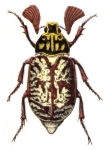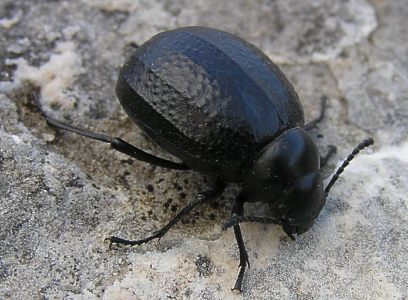|
Description / Habitats / Flora / Vertebrates / Insects / Invertebrates / What's that Bug? Home / Nestos Delta / Bibliography / About this site / Links / Contents / Galleries ____________________________________________________________________________ |
|
__________________________________________________________________________________________________________ THE DARKLING BEETLES (COL., TENEBRIONIDAE) OF THÁSOS Darkling beetles are a diverse group, comprising over 15,000 species
worldwide and inhabiting a wide range of habitats including deserts, sand dunes,
caves, and woodlands. Several species are synanthropic and are cosmopolitan
pests of stored
The taxonomic position of the Alleculidae and Lagriidae has been the subject of debate and they are regarded as sub-families of the Tenebrionidae by many authors. Similarly, the taxonomic status of many tenebrionid forms in the Aegean is unclear. A high proportion of the family is flightless and as such island populations frequently exhibit morphological differences. This has led to the description of numerous sub-species (Fattorini, Leo & Salvati 2000), but recent taxonomic revisions have clarified most of the historic confusion. Fattorini & Fowles (2006) summarise these changes as they affect the Aegean fauna and also correct mis-identifications appearing in the published literature for Thásos. The earliest published records for the island appear to be those of Karnozickij (1959), who recorded 12 taxa (representing 11 species) in October 1942 and May 1943. Ardoin (1976) added another seven species amongst the twelve species recorded by M. Cerruti on Thásos in 1973; Whitehead (1999) reported two species collected above Theologos in 1994; whilst Ferrer & Whitehead (2002) announced the important addition of Xanthomus graecus from Limenaria. Fattorini (2002) listed thirteen of these species as occurring on Thásos. During my visits I have recorded twenty-nine species (marked with an asterisk in the Checklist below), including fifteen species that are additions to the island list, and I am grateful to Simone Fattorini, Piero Leo and Paul Whitehead for assistance with identification. Serge Peslier (Soldati & Peslier 2016) visited the island in May 2009, specifically searching for tenebrionids, and recorded nineteen species from six sites. Nine of these species are additions to the island fauna, but three of these require confirmation or clarification (see below). In total, 41 tenebrionid species have been recorded from the island. Fattorini & Fowles (2006) report 132 native species of Tenebrionidae (excluding synanthropics) from the Aegean islands so it is likely that there are more species to be found on Thásos. However, species-area analysis of the Aegean fauna suggests that Thásos already has an exceptionally rich fauna for its size. On Lesbos, Leo & Ruzzante (2016) report that 35 tenebrionid species have been recorded. Almost two-thirds of the tenebrionid fauna on Thásos has an Eastern
Mediterranean distribution, most of which are Balkan in origin, and only a
single species,
Cephalostenus
orbicollis, is of Anatolian distribution. The island has, therefore,
probably received most of its species from the adjacent mainland during the
Pleistocene when glaciation lowered sea levels and probably connected
Thásos
to the mainland coast. Present-day habitat diversity may also encourage a
comparatively rich fauna, especially with regard to the prevalence of mature
broadleaved trees as habitat for xylophilous species such as
Bolitophagus
reticulatus, Helops rossii,
Nalassus
plebejus and
Palorus subdepressus.
The survival of undisturbed beaches and sand dunes, as at Cap Prinos
and Skala Potamias, is important for
psammophilous species like Ammobius
rufus, Opatrum obesum and Xanthomus
graecus.
Several of the species known from
Thásos have
been recorded on very few occasions from Greece according to Kühnelt (1965).
Bolitophagus reticulatus
is a mycophagous species associated with polypore fungi on trees,
previously known from Greece only from the Peloponnese. Diaclina fagi, found
on Thásos in bracket fungi on fallen poplars, is known from only three other locations in Greece.
Platydema europaeum, a mycetophagous species apparently linked to
polypores on pine logs and trunks, was previously known from Greece only from
Taygetos on the mainland and on Lesvos. Helops rossii, Melanimon tibialis and Nalassus
plebejus, are additions to the Aegean fauna, previously known for Greece
from the mainland and the Ionian Islands.
Opatrum sabulosum
is known
from the islands of Nissiros and Lesvos, and from continental Greece where it
appears to be very rare.
Xanthomus
graecus is restricted to the Peloponnese
and Thásos (Ferrer and Whitehead 2002), whilst
There is no single key available to identify the darkling beetles of Greece, but many species are widely distributed across Europe and hence covered by a variety of identification guides. Kühnelt (1965) provides a valuable, though taxonomically out-dated, summary of the Greek fauna. CHECKLIST Alleculinae Hymenalia graeca Seidlitz, 1896 Megischia galbanata (Kiesenwetter, 1861) * Omophlus lepturoides (Fabricius 1787) * Omophlus pilosellus Kirsch, 1869
Diaperinae Alphitophagus obtusangulus J. Müller, 1904 * Crypticus quisquilius (Linnaeus, 1760) * Platydema europaeum Laporte & Brullé 1831 *
Lagriinae Lagria hirta (Linnaeus 1758) *
Opatrinae Dendarus messenius (Brullé 1832) * Dendarus moesiacus (Mulsant & Rey 1854) * Gonocephalum granulatum pusillum (Fabricius, 1792) * Leichenum mucronatum Küster, 1849 Leichenum pictum (Küster, 1801) Opatrum obesum Olivier 1811 * Opatrum sabulosum Linnaeus 1758 *
Palorinae Palorus subdepressus (Wollaston) 1864 *
Pimeliinae Calyptopsis caraboides (Brullé 1832) Dailognatha quadricollis carceli Solier1835 * Dichillus carinatus (Küster 1848) * Graecopachys (Pachyscelis) quadricollis (Brullé 1832) Ceratanisus osellai (Scupola, 1984) * Pimelia subglobosa graeca Pallas 1781 * Tentyria rotundata angulata (Brullé 1832) * Zophosis punctata Brullé 1832 *
Stenochiinae Menephilus cylindricus (Herbst 1784) *
Tenebrioninae Ammobius rufus Lucas 1849 * Blaps gigas (Linnaeus 1767) Bolitophagus reticulatus (Linnaeus 1767) * Catomus consentaneus (Küster 1851) Cephalostenus orbicollis (Ménétriés 1836) * Diaclina fagi (Panzer 1797) * Ectromopsis bulgarica (G.S. Medvedev & Angelov, 1981) * Helops caeruleus (Linnaeus, 1758) Helops rossii Germar 1817 * Melanimon tibialis (Fabricius, 1781) * Nalassus plebejus (Küster 1850) * Odocnemis nigropiceus (Küster 1850) * Probaticus tenebricosus (Brullé, 1832) Tenebrio opacus Duftschmid 1812 Uloma rufa (Piller & Mitterbacher, 1783) * Xanthomus graecus Dajoz 1984
Unconfirmed species
In addition to a few currently unidentified Alleculinae, I have collected female specimens only of Euboeus (Pelorinus) sp. and Nalassus cf. graecus which require males for positive identification.
Soldati & Peslier (2016) include the following three taxa in their paper as having been newly recorded on Thásos: Dailognatha caraboides (Eschscholtz, 1831), Pimelia polita Solier, 1836, Pimelia verruculifera Solier, 1836. Fauna Europaea shows Dailognatha caraboides to be known only from Bulgaria and as D. quadricollis has been reported from the island on several occasions (eg. Ardoin 1976; Whitehead 1999) by other recorders it would be sensible to clarify which taxon is involved as it is perhaps unlikely that both are present. Pimelia polita and P. verruculifera are probably only phenotypes of P. subglobosa and they have not been formally recognised as distinct species (S. Fattorini pers. comm.). They also list Tentyria angulata at species level, but it has not been formally raised to specific status and until such time as that occurs it should be considered as a subspecies of T. rotundata (S. Fattorini pers. comm.).
REFERENCES
Angelov P.A. & Medvedev, G.S. 1981. Darkling beetles (Coleoptera, Tenebrionidae) of Bulgaria. Entomologicheskoe obozrenie. 60: 302–315. [in Russian] Ardoin, P. 1976. Tenebrionidae récoltés par Monsieur M. Cerruti dans diverses iles Grecques. Fragmenta Entomologica, 12: 69-79. Fattorini, S. 2002. Biogeography of the tenebrionid beetles (Coleoptera, Tenebrionidae) on the Aegean Islands (Greece). Journal of Biogeography, 29: 49-68. Fattorini, S. & Fowles, A.P. 2006. A biogeographical analysis of the tenebrionid beetles (Coleoptera, Tenebrionidae) of the island of Thasos in the context of the Aegean Islands (Greece). Journal of Natural History, 39: 3919-3949. Fattorini, S., Leo, P. & Salvati, L. 2000. Levels of endemism in the Aegean tenebrionids (Coleoptera, Tenebrionidae). Biogeographia, 21: 429-440. Ferrer, J. & Whitehead, P.F. 2002. The genus Xanthomus Mulsant, 1854 (Coleoptera, Tenebrionidae), its evolutionary history and conservation significance. Annales Zoologici (Warszawa), 52: 383-401. Karnozickij, N. 1959. Materialien zur Koleopteren-Fauna der Agäischen Küste und Insel Thasos. Izv. zool. Inst. Sof., 8: 237-253. Kühnelt, W. 1965. Tenebrionidae. Catalogus Faunae Graeciae. 1. Leo, P. & Ruzzante, G. 2016. Dati nuovi e riassuntivi sui Tenebrionidi dell’isola di Lesbo (Grecia) (Coleoptera Tenebrionidae). Boll. Soc. Entomol. Ital., 148: 83-89. Schawaller, W. 1996. Tenebrionidae (Coleoptera) aus Nord-Griechenland: Habitate, Artengesellschaften und Verbreitung. Entomologische Blaetter fuer Biologie und Systematik der Kaefer, 92:3-18. Soldati, F. 2008. Alphitophagus obtusangulus J. Muller, 1904 (Coleoptera Tenebrionidae): premičres citations pour la France et la Grčce. Bulletin mensuel de la Société linnéenne de Lyon, 77: 22-25. Soldati, F. & Peslier, S. 2016. Coléoptčres Tenebrionidae récoltés par Serge Peslier durant ses récents voyages entomologiques en Grčce. Revue de l’Association Roussillonnaise d’Entomologie, XXV: 217 – 240. Whitehead, P.F. 1999. A second male of Tapinopterus insulicola (Tscitschérine, 1900) (Coleoptera: Carabidae). Entomologist's Gazette, 50: 53-54.
|

















 products. A general trait, at least amongst the European
species, is an affinity for dry, warm habitats and a majority of species are
associated either with free-draining open habitats, such as sandy beaches, or
with dead wood where several species feed on fungi. This ability to withstand
arid conditions makes tenebrionids well-suited to the climate of Thásos and in
the lowlands they are usually the commonest ground-active beetles
encountered, replacing the Carabidae of more temperate climes. Species such as Tentyria
rotundata and Pimelia subglobosa are frequently seen in suitable
habitats. Tenebrionids are variable in
size, ranging from 3-30mm in length, and are also very diverse in their form.
Many (like the cellar beetle Blaps gigas) resemble black ground beetles,
whilst others are rotund, shiny and brightly-coloured.
products. A general trait, at least amongst the European
species, is an affinity for dry, warm habitats and a majority of species are
associated either with free-draining open habitats, such as sandy beaches, or
with dead wood where several species feed on fungi. This ability to withstand
arid conditions makes tenebrionids well-suited to the climate of Thásos and in
the lowlands they are usually the commonest ground-active beetles
encountered, replacing the Carabidae of more temperate climes. Species such as Tentyria
rotundata and Pimelia subglobosa are frequently seen in suitable
habitats. Tenebrionids are variable in
size, ranging from 3-30mm in length, and are also very diverse in their form.
Many (like the cellar beetle Blaps gigas) resemble black ground beetles,
whilst others are rotund, shiny and brightly-coloured.